Find these visible planets in July 2021: Jupiter, Saturn, Mars, Venus, Mercury
Try Stellarium for a precise view from your location.
Click here for recommended almanacs, which provide precise rise and set times.
Moon guide to July’s visible planets

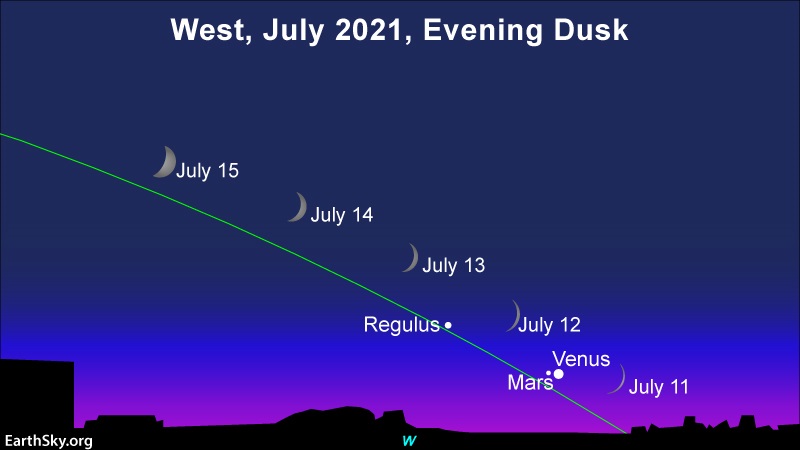
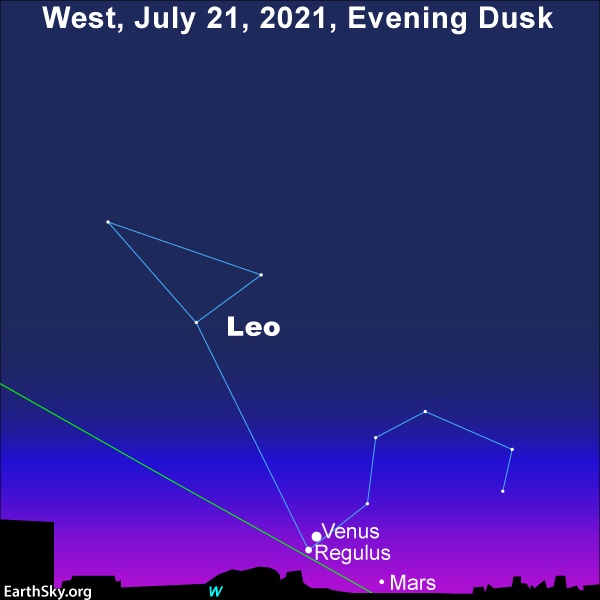
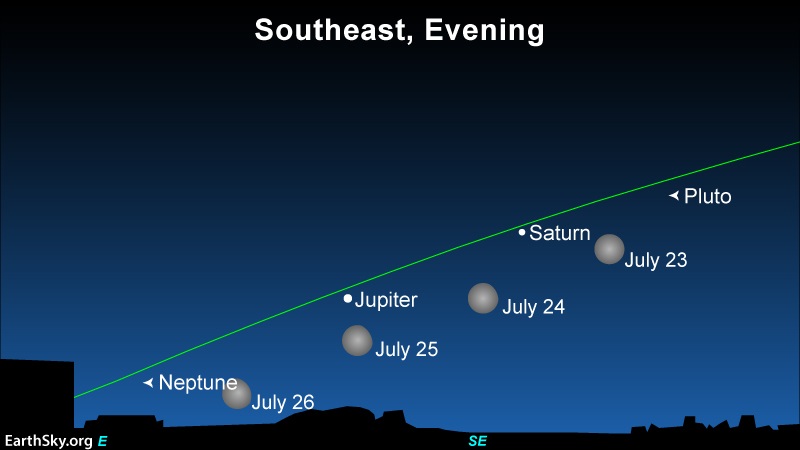

Venus and Mars
The brightest planet Venus and red planet Mars remain fixtures of the early evening sky throughout July 2021. Your best bet is to spot dazzling Venus first, and then to seek out fainter Mars. You’ll likely find Venus blazing away in your western sky some 40 to 45 minutes (or sooner) after sunset. Mars won’t pop out in the vicinity of Venus until dusk gives way to nightfall.
Mars starts out the month above Venus, and ends the month below Venus. Day by day, Venus climbs upward, away from the setting sun. Day by day, Mars sinks downward, toward the setting sun. The two will meet up for a conjunction on July 13, around 9 hours UTC. Depending on where you live worldwide, the twosome will appear closest together on the sky’s dome on July 12 or 13.
Best of all, the lunar crescent helps to guide your eye to Venus and Mars at dusk/nightfall from July 11 to 14. Modestly bright Mars is fairly easy to see in a dark sky. But it might be hard to spot Mars next to Venus from mid-and-far northern latitudes, where these two worlds set before nightfall.
If that’s the case, try your luck with binoculars.
To find out Venus’ or Mars’ setting time, go to TimeandDate or Old Farmer’s Almanac.
By the way, it’s best to view Mars in the first half of July. The red planet is only going to get fainter as the month progresses. Mars will dim as – day by day – it lags farther behind Earth in the great race of the planets. During this time, Mars will be sinking closer to the setting sun. Though nominally an evening planet until October 2021, Mars will likely be out of sight and out of mind by August 2021. Sometime during that month, Mars will succumb to the glow of evening twilight.
At mid-northern latitudes, Mars sets around nightfall (end of astronomical twilight) in early July, and around 1/2 hour (30 minutes) before nightfall by July’s end.
At temperate latitudes in the Southern Hemisphere, Mars sets about one hour (60 minutes) after nightfall in early July, and about 1/2 hour (30 minutes) after nightfall near the month’s end.
Find out both the sunset time and the time of nightfall (end of astronomical twilight) via TimeandDate.com
Read more: What to expect from Mars in 2021
On the other hand, Venus boldly shines in the evening sky for the rest of this year, to reach its greatest elongation from the sun on October 29, 2021 (see diagram below). Moreover, Venus will attain its greatest brilliance as the evening “star” at the time of the new moon on December 4, 2021.
Circle this date on your calendar, and see if it’s true that Venus can cast a shadow on a dark night!
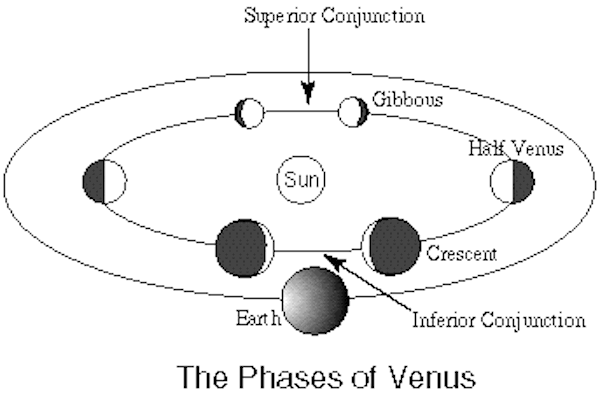
Jupiter and Saturn
In July 2021, you can see the giant planet Jupiter and ringed planet Saturn from mid-evening until dawn. They’re nearly at their most glorious this month. Both of them will have an opposition, when they will appear opposite the sun as seen from Earth, in August. Opposition marks the middle of the best time of year to see a planet. Thus Jupiter and Saturn are nearly at their best! Look for them in your southeast sky before your bedtime. Or get up early to watch for these two worlds higher up in the sky during the predawn hours.
Saturn rises first. Around the world, Saturn rises at about the same time that Mars sets at the beginning of the month. By the month’s end, Saturn will rise at sunset. It’s opposition will come on August 2. Throughout the month, at mid-northern latitudes, Jupiter follows Saturn into the sky about an hour (60 minutes) after Saturn comes up.
At temperate latitudes in the Southern Hemisphere, Jupiter follows Saturn into the sky around 1 1/2 hours (90 minutes) after Saturn rises.
For more specific information on when Jupiter and Saturn rise into your sky, consult either The Old Farmer’s Almanac (U.S. and Canada) or TimeandDate.com (worldwide).
Use the full moon to help guide you to Jupiter and Saturn on July 23 and 24, 2021. The chart below shows the moon, Jupiter and Saturn for June 24, as viewed from mid-northern North American latitudes.

Mercury
Your best chance of catching Mercury – the innermost planet, often call the most elusive planet – is in the first half of July 2021. This planet sits low in the east at morning dawn, rising some 75 to 90 minutes before sunrise. To find out Mercury’s precise rising time for your sky, click on TimeandDate (worldwide) or Old Farmer’s Almanac (USA and Canada).
The waning moon will point to Mercury on July 5, 6 and 7. It’ll have moved past Mercury by July 8. Read more about moon and Mercury.
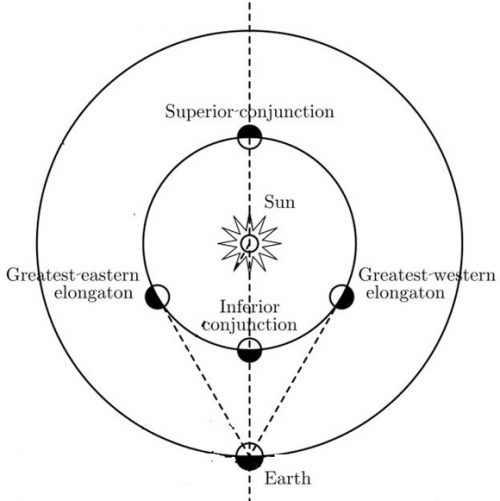
Which ones are the bright planets?
In their outward order from the sun, the five bright planets are Mercury, Venus, Mars, Jupiter and Saturn. These are the planets easily visible without an optical aid. They’re the planets watched by our ancestors since time immemorial. These planets do appear bright in our sky. They are typically as bright as – or brighter than – the brightest stars. Plus, these relatively nearby worlds tend to shine with a steadier light than the distant, twinkling stars.
You can spot them, and come to know them as faithful friends, if you try.

Don’t miss anything. Subscribe to EarthSky News by email
Visit EarthSky’s Best Places to Stargaze to find a dark-sky location near you.
Help EarthSky keep going! Donate now.
Post your planet photos at EarthSky Community Photos.
Bottom line: All you need to know about how to find the bright planets of the solar system during the month of July, 2021.
The post July 2021 guide to visible planets first appeared on EarthSky.
from EarthSky https://ift.tt/2SL2h7q
Find these visible planets in July 2021: Jupiter, Saturn, Mars, Venus, Mercury
Try Stellarium for a precise view from your location.
Click here for recommended almanacs, which provide precise rise and set times.
Moon guide to July’s visible planets





Venus and Mars
The brightest planet Venus and red planet Mars remain fixtures of the early evening sky throughout July 2021. Your best bet is to spot dazzling Venus first, and then to seek out fainter Mars. You’ll likely find Venus blazing away in your western sky some 40 to 45 minutes (or sooner) after sunset. Mars won’t pop out in the vicinity of Venus until dusk gives way to nightfall.
Mars starts out the month above Venus, and ends the month below Venus. Day by day, Venus climbs upward, away from the setting sun. Day by day, Mars sinks downward, toward the setting sun. The two will meet up for a conjunction on July 13, around 9 hours UTC. Depending on where you live worldwide, the twosome will appear closest together on the sky’s dome on July 12 or 13.
Best of all, the lunar crescent helps to guide your eye to Venus and Mars at dusk/nightfall from July 11 to 14. Modestly bright Mars is fairly easy to see in a dark sky. But it might be hard to spot Mars next to Venus from mid-and-far northern latitudes, where these two worlds set before nightfall.
If that’s the case, try your luck with binoculars.
To find out Venus’ or Mars’ setting time, go to TimeandDate or Old Farmer’s Almanac.
By the way, it’s best to view Mars in the first half of July. The red planet is only going to get fainter as the month progresses. Mars will dim as – day by day – it lags farther behind Earth in the great race of the planets. During this time, Mars will be sinking closer to the setting sun. Though nominally an evening planet until October 2021, Mars will likely be out of sight and out of mind by August 2021. Sometime during that month, Mars will succumb to the glow of evening twilight.
At mid-northern latitudes, Mars sets around nightfall (end of astronomical twilight) in early July, and around 1/2 hour (30 minutes) before nightfall by July’s end.
At temperate latitudes in the Southern Hemisphere, Mars sets about one hour (60 minutes) after nightfall in early July, and about 1/2 hour (30 minutes) after nightfall near the month’s end.
Find out both the sunset time and the time of nightfall (end of astronomical twilight) via TimeandDate.com
Read more: What to expect from Mars in 2021
On the other hand, Venus boldly shines in the evening sky for the rest of this year, to reach its greatest elongation from the sun on October 29, 2021 (see diagram below). Moreover, Venus will attain its greatest brilliance as the evening “star” at the time of the new moon on December 4, 2021.
Circle this date on your calendar, and see if it’s true that Venus can cast a shadow on a dark night!

Jupiter and Saturn
In July 2021, you can see the giant planet Jupiter and ringed planet Saturn from mid-evening until dawn. They’re nearly at their most glorious this month. Both of them will have an opposition, when they will appear opposite the sun as seen from Earth, in August. Opposition marks the middle of the best time of year to see a planet. Thus Jupiter and Saturn are nearly at their best! Look for them in your southeast sky before your bedtime. Or get up early to watch for these two worlds higher up in the sky during the predawn hours.
Saturn rises first. Around the world, Saturn rises at about the same time that Mars sets at the beginning of the month. By the month’s end, Saturn will rise at sunset. It’s opposition will come on August 2. Throughout the month, at mid-northern latitudes, Jupiter follows Saturn into the sky about an hour (60 minutes) after Saturn comes up.
At temperate latitudes in the Southern Hemisphere, Jupiter follows Saturn into the sky around 1 1/2 hours (90 minutes) after Saturn rises.
For more specific information on when Jupiter and Saturn rise into your sky, consult either The Old Farmer’s Almanac (U.S. and Canada) or TimeandDate.com (worldwide).
Use the full moon to help guide you to Jupiter and Saturn on July 23 and 24, 2021. The chart below shows the moon, Jupiter and Saturn for June 24, as viewed from mid-northern North American latitudes.

Mercury
Your best chance of catching Mercury – the innermost planet, often call the most elusive planet – is in the first half of July 2021. This planet sits low in the east at morning dawn, rising some 75 to 90 minutes before sunrise. To find out Mercury’s precise rising time for your sky, click on TimeandDate (worldwide) or Old Farmer’s Almanac (USA and Canada).
The waning moon will point to Mercury on July 5, 6 and 7. It’ll have moved past Mercury by July 8. Read more about moon and Mercury.

Which ones are the bright planets?
In their outward order from the sun, the five bright planets are Mercury, Venus, Mars, Jupiter and Saturn. These are the planets easily visible without an optical aid. They’re the planets watched by our ancestors since time immemorial. These planets do appear bright in our sky. They are typically as bright as – or brighter than – the brightest stars. Plus, these relatively nearby worlds tend to shine with a steadier light than the distant, twinkling stars.
You can spot them, and come to know them as faithful friends, if you try.

Don’t miss anything. Subscribe to EarthSky News by email
Visit EarthSky’s Best Places to Stargaze to find a dark-sky location near you.
Help EarthSky keep going! Donate now.
Post your planet photos at EarthSky Community Photos.
Bottom line: All you need to know about how to find the bright planets of the solar system during the month of July, 2021.
The post July 2021 guide to visible planets first appeared on EarthSky.
from EarthSky https://ift.tt/2SL2h7q

Aucun commentaire:
Enregistrer un commentaire